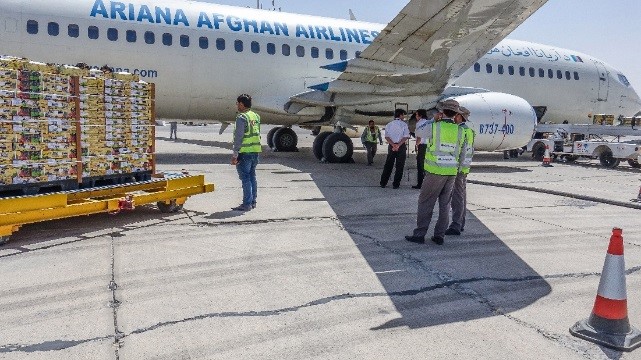

The Sky’s the Limit: Unlocking Afghanistan’s Exports with Air Cargo
By Abdul Moheet, Export Advisor, Afghanistan Trade and Revenue (ATAR) Project and Ian Carver, Communications Specialist, ATAR
Afghanistan’s economy is heavily reliant on imports. The country’s imports totalled $6.67 billion in 2016, dwarfing its $604 million in exports. As the country transitions to a more export-oriented economy, transporting goods by air can provide significant opportunities to increase economic growth.
Afghanistan’s ability to boost exports is hampered by its landlocked location and its tense relationship with Pakistan, through which exports travel to Afghanistan’s chief trade partner, India. Afghan traders using land transportation often encounter unpredictable administrative trade barriers, usually for political reasons. Pakistan has closed its border with Afghanistan during the peak of fresh fruit season on multiple occasions, further limiting Afghan exports. Poor security and costly transshipping delays are other challenges to road transport.
Air cargo offers a faster, more secure, and more reliable mode of shipment and requires less packaging and lower insurance than other modes of transport. However, air cargo is not entirely new for Afghan exporters. In the past several years, exports by air have ranged from about 10 to 20 percent of the country’s total exports. In 2016, 13 percent of all Afghan exports were shipped by air. India is by far the biggest destination, consuming 87percent of Afghan exports shipped by air.
But not all products are suitable for air transport. Goods with high value-to-weight ratios and time-sensitive products are mainly sent by air, as their high value justifies the costs of air freight. Overall, spices and resins, such as
asafetida, account for 83 percent of Afghanistan’s exports by air. At present, there are serious supply problems when it comes to some of Afghanistan’s other chief exports such as carpets and fresh and dried fruits and nuts. But as Afghans benefit from programs designed to increase production and strengthen supply chains, air cargo will be an option for a growing number of businesses.
To capitalize on its improving trade ties with India, the Afghan government launched an air corridor to New Delhi in June 2017. Since then, more than 900 tons of products have been air lifted to India. However, to increase the viability of air cargo, trade should flow in both directions. Afghanistan lacks the regulatory and logistical scaffolding to make air cargo sustainable over the long term. The Afghan government and private sector are only starting to make use of modern warehousing and freight forwarding services and implement customs reforms to expedite air shipments.
To make air cargo economically feasible for more exporters, Afghanistan is now pursuing the “hub-and-spokes model,” a globally recognized practice that helps suppliers save money by optimizing space. Using this model, freight forwarders collect cargo from its point of origin (the tips of the spokes) and transport it back to a central processing facility (the hub). The shipment is then either warehoused or distributed directly from the hub. The Dubai Free Zone is one such hub that Afghan traders are now using as part of the larger logistics system.
To facilitate air shipments over the long term, efforts to upgrade the air cargo capacity of Kabul’s Hamid Karzai International Airport (HKIA) are also underway. A modern air cargo terminal will address security concerns that prevent many airlines from collecting cargo in Kabul. With a secure terminal to call, flagship airlines such as Emirates and other airlines with wide-bellied planes will be more willing to do more business with Afghanistan. In addition, one-stop-shops, with their streamlined customs clearance steps that become automated over time, will assist exporters overcome the challenge of completing export documents manually at multiple agencies at HKIA and other national airports.
The benefits will extend beyond exporters. Air cargo will open up opportunities for service providers to cater to exporters’ stocking and warehousing requirements in meeting global best practices. The logistics service sector is a crucial part of air cargo operations and can serve as a catalyst for job creation in Afghanistan. Healthy competition between private logistics players will pull the cost down and make air cargo services affordable and beneficial for the end customer. Afghanistan’s logistics market is completely untapped for big multinational logistics providers. Opening up this sector for local private players will also attract global service providers to start operations and elevate capacity to global standards.
USAID’s
Afghanistan Trade and Revenue (ATAR) Project, implemented by Chemonics International, is helping boost air cargo shipments and improve the air cargo capacity of Afghan airport, as outlined with the U.S. strategy in the region. The U.S. is now focusing on shoring up security in the country’s main urban centers along with economically vital regions, some of which are home to lucrative deposits of precious gems and minerals. Upgrades to the country’s main airports will improve communications and supply links between these cities, and solidify trade ties with key partners and regional markets abroad. Established air bridges to India, the Middle East, and the Eurasian Economic Union will bolster the country’s importance in the region and push regional powers to take a positive stake in Afghanistan’s future, helping to foster the regional consensus needed to resolve the country’s conflict. The Afghan government will gain important leverage in negotiations with neighboring countries that currently impose administrative trade barriers on its exports with little worry of consequence. These countries should know that Afghanistan has other options.
Air transport is the most modern form of transportation, and far more susceptible to international compliance than other modes of transport. An established air cargo system will reflect the maturity of Afghanistan’s trade policy. With no access to the sea or navigable rivers and underdeveloped rail and road networks, air cargo is an attractive mode of transport for Afghan traders. It also provides the government with an important instrument of state economic development to increase economic growth and prove to the international community that Afghanistan is a reliable and secure trade partner.
This article was originally featured on
Chemonics International’s blog.

To boost trade, Chemonics’ ATAR project worked with the Afghan government to provide a new means to help
products like dried fruits and nuts reach a global market. (photos by Chemonics)